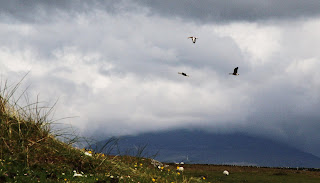This should really be a picture of a ready to go kayak with no kayaker. We all have those days when we forget something, like the VHF for example. I searched all the hatches, dry bags and the cockpit several times. I turned the car inside out, twice. My wife went back to our hotel room, as did I subsequently. Could we find the blasted thing? No. I'd just about given up when I suddenly remembered ..... back at the hotel I'd put it in the hydration pack pocket in the rear of my BA. Argh! An hour or so wasted.
So eventually, off I paddled up the north-east cost of Colonsay. Can you detect my mood from my posture?
Having paddled about a kilometre north from Scalasaig I had eventually paddled out my mood and was fairly chilled out like these four feral goats, presumed ancestors from goats that wound up on several Scottish islands after the Armada.
Further up the coast again are the ruins of Riasg Buidhe. An eighth century cross where the stone is described by William Stevenson in 1880 as "dressed only in front, undressed on the back" was removed from here in 1870 to Tobar Odhran by Colonsay House. Suffice to say there's Christian symbology on the front and and something rather ruder on the back! The 1841 census has 64 people living here and the village remained occupied to a lesser extent until 1923, when the last inhabitants were re-housed in new houses at Glassard, just north-east of Scalasaig. With that move Colonsay became the first community in Britain where every household had running water and lavatories. The roofs of the houses at Riasg Buidhe were burnt to prevent their reoccupation. A certain Collach, Dr. Roger McNeill, an internationally recognised authority on infectious diseases, particularly tubercolosis, was the prime mover in this achievement. This and more information can be gleaned from Kevin Byrne's excellent book, "Lonely Colonsay, Island at the Edge".
Heading north the coastline scenery takes on a certain uniformity with the exception of Eilean Olmsa and the woodlands of A' Choille Mhor and A'Choille Bheag. Seals, otters and goats abound and there is the chance to spot a goldean eagle. Landing opportunities are limited until you reach the beach at Balnahard or Traigh Ban.
From Balnahard it is only a short paddle to the cliffs at the north of Colonsay. The fulmars hereabouts were very inquisitive, flying within catching distance of my head.
On reaching the northern tip, where the tide can really pull you along or push you back, the skerry of Eilean Dubh comes in to view as does the view towards Mull and northern Jura. Views to follow!





































